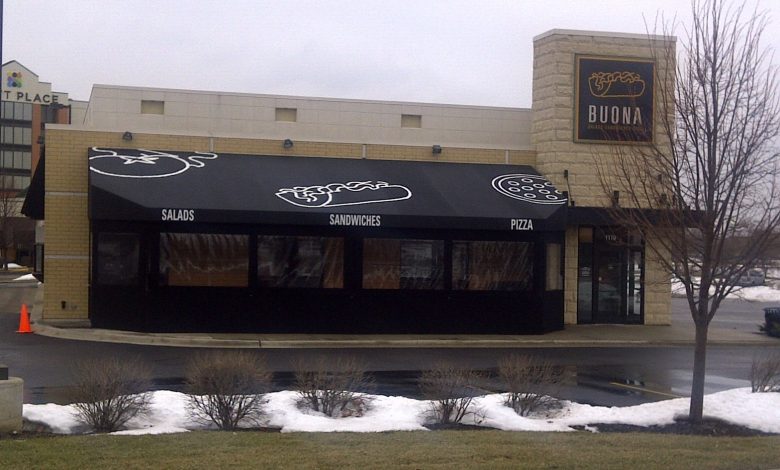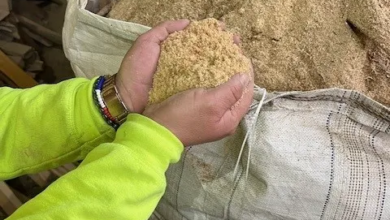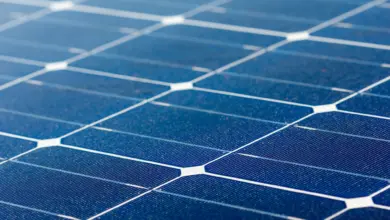Materials for Creating Awnings
Materials used to make today's awnings are more varied than ever
An awning has a dual purpose for a business-it provides the obvious of sun, snow, and rain protection, but it also can be a great place for signage or the visual brand of a storefront.
“Putting your sign on the awning can be a very tasteful way to advertise your business as well as save you money,” says Peter Douglas, Cooley Group. “Because the awning is a structure itself, you only need to add the graphics, which will save you money over making a separate sign.”
About half of awnings are used for signage, typically with the company name, logo, or street or building number on the canopy, or shade structure, and half as architectural or protective features on buildings.
“Awnings can make a building. They dress up what in some cases are old or rundown buildings or accentuate the architecture,” Douglas adds. “Awnings can set the tone of the business before you even get inside. They finish the look of the building from an aesthetic standpoint.”
Awnings also are the first thing a customer or guest sees, says David Swers, president of Glen Raven Custom Fabrics Inc.
“It’s important that it stands out, is visually appealing, and communicates clearly,” Swers says. “From an aesthetics and design perspective, they can also dress up and add elegance to an otherwise plain storefront or face of a building.”
The process for adding graphic elements to make awnings stand out, even more, is fairly simple but does require the right equipment and a material that can provide the needed functionality while withstanding the elements.
Awning materials
The canopy primarily comes in corrugated metal and canvas, followed by a vinyl-coated backlit material, which allows light to pass through to illuminate the graphics, says Mike Yopp, president of Z3 Graphics Inc., an awning manufacturer with awning re-cover capabilities.
Other common materials for the canopy include fabrics such as woven synthetic fabrics and flexible polyvinyl chloride composite textile, as well as harder materials like galvanized steel, aluminum, and solution-dyed acrylic.
“Because fabric awnings have been around for hundreds of years, I would say that metal is growing in popularity,” Douglas says. “They may look more industrial, but it seems to be growing.”
Metal, however, has some drawbacks, such as the cost, level of noise in heavy rain or hale, and the need to be repainted, Douglas says. He also has seen gray marks on buildings where rain has hit the hardware or fasteners and run onto the canopy, as well as thermo bridging from the heat generated by the sun hitting the metal.
Canopies typically come in two shapes, slant or flat, Yopp says. Slanted generally are three to five feet in height and slant off the side of the building 2′-5′ to form a triangular shape. The flat style is 10″-12″ in height and extends out from the wall 3′-5′, held up by support arms.
The assembly process
To assemble the awnings, more awning manufacturers are investing in technology to improve the accuracy and efficiency in their production processes, says Craig Zola, vice president of marketing and distribution, Herculite Products, a textile manufacturer of several awning fabric brands. The manufacturers are moving away from manual fabric cutting and assembly to using computer-based cutters and plotters and thermal welding equipment for the seaming and assembly, he says.
“These methods reduce fabric waste and improve the speed of project throughput,” Zola says, adding that the manufacturers can produce textiles with more consistent physical characteristics in the stretch and dimensional stability.
The awning fabric or other material is supported by a frame made out of square piping or tubing in two primary materials of steel and aluminum. Steel is hot-dipped in galvanization to rust-proof the inside and outside, while aluminum doesn’t need treatment because it does not corrode.
“Steel is heavier but size for size much stronger and it costs less to purchase,” Douglas adds. “Aluminum requires more material to get the same strength as steel, but it is lighter for the install and cleaner in the fabrication process and lasts indefinitely.”
The awning has fasteners at the top to anchor it in place and outbars at the bottom, which extend out to the front and support the canopy. The frame is installed by using the fasteners, dictated by the type of surface for the mounting.
For a block wall or concrete building surface, Z Clips typically are used, which are mounted to the surface using a fastener, such as a tapcon or sleeve anchor. The awning tubing is set into the top of the Z Clip, where a one-inch gap is formed between the clip and surface, and the awning is anchored in place. Z Clips also can be used for wood, but instead of a tapcon or sleeve anchor, the clip is held in place by self-capping screws, Yopp says.
For a dryvit surface, a synthetic version of cement siding, the awning is bolted through the dryvit to the studs or sub-frame behind it, Yopp says.
“Awning companies generally like to have the awning as complete as possible for install to minimize the amount of time on site,” Douglas explains. “This is where a fabric cover awning has a tremendous advantage over a metal awning, which usually has to be assembled on site.”
Following the codes
Once assembled, the awnings are installed according to geographical building codes. In some areas, engineered drawings are required for the framing and installation for projections above 36 inches to protect against uploads and snow loads.
“Remember, with any type of awning fabric or metal, you have to guard against it coming down and wind blowing it up. If you follow your codes, you shouldn’t have a problem,” Douglas adds.
The codes, which differ according to locale, generally require a certain number of fasteners at the top of the awning and outbars at the bottom.
“Traditionally, a safe bet is to put Z brackets (another fastener option) on the end of each awning and two feet across along the head,” Douglas says, adding that the outbars generally are placed every eight feet but with engineered drawings can be less.
The national building code for awnings on commercial buildings also requires the canopy fabric to be flame-retardant.
“Some fabricators are sending out fabrics that are not flame-retardant and getting them topically treated, which is like putting on sunscreen. It will wash off over time,” Douglas says.
Vinyl presents a good choice, since most vinyl is PSV (pressure-sensitive vinyl) receptive or screen printable and provides a level of protection from the rain, as well as being flame-retardant, Douglas says.
“They are engineered to withstand the harsh environments around the world,” Zola says. “The outdoor life of high-performance digital inks has greatly improved in recent years. Outdoor life can be improved even further by using clear top coats.”
Once installed, awnings end up being an inexpensive addition to a building.
“They enhance the overall appearance of the building. They give it dimensional shapes,” Yopp says. “Rather than building onto a building, they can do so through the use of an awning.”
Adding an awning mostly presents benefits with few drawbacks, according to Swers.
“Benefits definitely include brand recognition and creating a stronger corporate identity, as well as extending the theme or décor of an establishment to the outdoors,” Swers says. “If there are any drawbacks, it just might be that in some cases, the fabric itself may outlast the printed image even with UV protection.”










